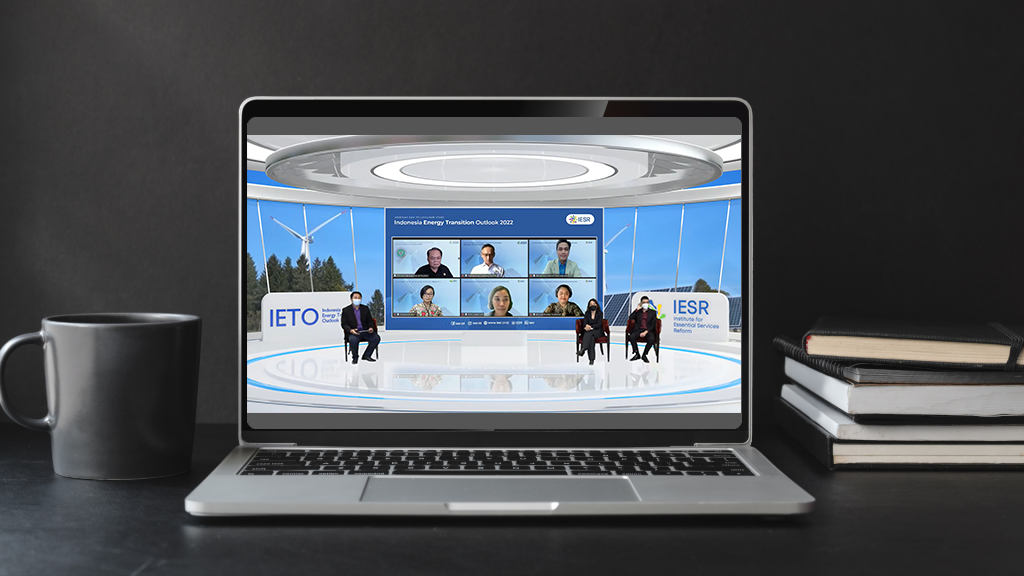Jakarta, December 21, 2021 – Closing 2021, the Institute for Essential Services Reform (IESR) has launched its annual report entitled Indonesia Energy Transition Outlook (IETO) 2022. Since 2017, IETO – previously called Indonesia Clean Energy Outlook (ICEO), has consistently explained the development of the energy transition in Indonesia in various sectors as well as provided projections of Indonesia’s energy transition in 2022. For the second year in a row, IETO has specifically analyzed Indonesia’s energy transition readiness.
At a global level, 2021 was marked by some important events such as the Climate Summit hosted by the US president, Joe Biden, who called for the whole world to take more ambitious steps to tackle the climate crisis. The G20 Summit and COP 26 reiterated that the commitments and actions to mitigate the climate crisis of all countries are still not sufficient to suppress the increase in the global average temperature of 1.5 degrees Celsius. More ambitious and aggressive climate mitigation actions are needed.
Although not yet in line with the Paris Agreement, Indonesia has begun to show a quite progressive political commitment by setting a net-zero target by 2060 or earlier, plans to retire 9.2 GW coal-fired power plants early, and the issuance of a new RUPTL which gives the share of renewable energy up to 51.6%. According to IESR, this commitment can be seen as a breath of fresh air for the development of renewable energy in Indonesia. However, this still has not been able to accelerate Indonesia’s energy transition, and achieve the Paris Agreement target of achieving carbon neutrality by the middle of this century.
Julius Cristian, the lead author of the IETO 2022 report, saw some uncertainty from the government.
“For example, although the latest RUPTL has accommodated about 50% of renewable energy or around 20 GW when compared to the need for decarbonization which reaches 130 GW, this plan is certainly far from what is needed. In addition, the government is still relying on strategies that we think are not feasible, such as the use of nuclear and CCS which are more expensive than renewable energy,” he explained.
The IETO 2022 assesses that Indonesia is capable of achieving net-zero by 2050. To achieve this, Indonesia must reach peak emissions before 2030, and after that start reducing them. One of the implications of this is that Indonesia is no longer allowed to build CFPPs and must immediately start retiring old CFPPs.
Considering the potential and availability of resources, solar PV will be the backbone of Indonesia’s decarbonization. However, its growth in 2021 was only around 18 MW, even though the demand will reach 108 GW in 2030, or an average increase of 10 GW per year.
Handriyanti Diah Puspitarini added that there has been a slight improvement in terms of policy quality and social (public acceptance) regarding the energy transition, but commitment from the government and the renewable energy investment climate still needs a lot of improvement.
“We need to see how the implementation of various regulations that will come and have been issued will be implemented. The government must also realize that the public has begun to be aware of this issue and support the energy transition, so the government should also support this already high public support,” explained Handriyanti.
Herman Darnel Ibrahim, a member of the National Energy Council (DEN), stressed the importance of renewable energy to grow exponentially to meet electricity demand and meet international agreement targets. Although throughout 2021 there is a momentum for growing awareness to transition Indonesia’s policy direction, it is still uncertain where it will go.
“For example, RUED, although the regions already have RUED, the authority to execute is centralized in PLN and Pertamina, so these regions have RUED but cannot affect the results,” said Herman.
Faela Sufa, Southeast Asia Director of ITDP, sees that the transportation sector can be one of the drivers of the renewable energy ecosystem in Indonesia.
“For example, for the electrification of public transportation, we need to synchronize together and identify what incentives need to be given so that it can be more tangible in energy use and coordination with various sectors related to renewable energy for electrification,” explained Faela.
Yusrizki, Chairman of the Standing Committee of the Indonesian Chamber of Commerce (KADIN) for New and Renewable Energy, said that KADIN has declared it will become a net-zero organization in 2060 and is actively encouraging its members to have a-net zero target.
“In the 2022 G20 summit, we are expected to have 100 Indonesian companies that have pledged a net-zero target and this is a very ambitious target. We start from education, assisting -helping them to make their agenda-, to pledge their commitment,” Yusrizki explained.
Meanwhile, Arief Sugiyanto, Vice President of PLN’s RUPTL Control, explained that his party is currently trying to meet the energy mix target of 23% by 2025.
“The target of 23% NRE in 2025 is indeed a formidable challenge. One of PLN’s strategies is to change diesel power generators in isolated areas gradually with NRE generators available in those locations,” said Arief.

